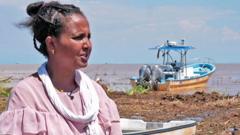As the sun dipped below the horizon of Lake Turkana, agony filled the air as Senait Mebrehtu honored the memory of her teenage daughter, Hiyab, who tragically drowned while attempting to reach Kenya via a perilous route employed by human traffickers. Senait, a Pentecostal Christian from Eritrea who sought asylum in Kenya three years prior, made her pilgrimage to this vast lake to confront the site of her daughter’s loss.
Hiyab, only 14 years old, made the fateful journey with her sister who survived the treacherous crossing. Senator recounted her horror at learning about the dangers of the lake, stating, "If the smugglers had told me such a dangerous lake existed, I would never have allowed my daughters to embark on this journey."
Senait had initially landed in Nairobi with her two younger children under a tourist visa, escaping religious persecution in militarized Eritrea, known for its harsh national service, which can often include forced labor. Following persistent pleas from her older daughters to join her, she consulted relatives who subsequently engaged smugglers to facilitate their escape from Eritrea.
The girls undertook a long and precarious journey beginning with road travel and foot crossings through Ethiopia before arriving at Lake Turkana, the world’s largest permanent desert lake. A smuggler confirmed that this route had become increasingly popular due to intensified patrols on roads leading into Kenya. Dubbed the "digital route," this new method of trafficking reflects evolving smuggling practices where traffickers exploit desperate migrants seeking safety.
As the logistics of smuggling shifted, Senait discovered that her daughters' fates were now governed by traffickers. A female smuggler, who spoke on the condition of anonymity, disclosed that her earnings per migrant are about $1,500, a sum that highlights the lucrative nature of her operations spanning multiple East African nations.
Tragically, during the crossing, Hiyab’s boat capsized approximately 300 meters offshore. Osman, another Eritrean migrant who witnessed the event, recalled how the vessel, overloaded with passengers, collapsed under a strong wind's force, resulting in the deaths of seven individuals. Hiyab's sister narrowly survived by holding onto the nearly submerged boat until other smugglers intervened.
Senait holds the smugglers accountable, asserting that neglect and recklessness led to the casualties. “They overloaded the boat,” she lamented, asserting that it was designed for far fewer than the 20 individuals they crammed into it.
During the BBC's investigation, local fishermen reported encountering bodies believed to be migrants washed ashore, further illustrating the grave reality faced by many on these treacherous crossings.
The UNHCR recently estimated that there are around 345,000 Eritrean refugees in East Africa, driven from their homes by military conscription and governmental oppression. As conflicts in neighboring Ethiopia and Sudan worsen, countries such as Kenya and Uganda increasingly attract those fleeing.
Despite the perilous journeys and potential for exploitation, many migrants still refer to these nations as potential sanctuaries. However, the smuggling networks remain active, leading migrants to transient holding locations in Nairobi where they often face further exploitation and, tragically, even death due to starvation.
"I have witnessed the grief of families waiting for the return of loved ones, only to be fed lies about their fate," the female smuggler admitted. While she admitted remorse for her role, she had no plans to retreat from the lucrative trade.
For Senait Mebrehtu, who still mourns Hiyab's death, the hope lingers that her surviving daughter remains safe. "We share the pain every Eritrean family endures," she said in a voice shrouded in sorrow. "May God heal our land and free us all from this suffering."

















